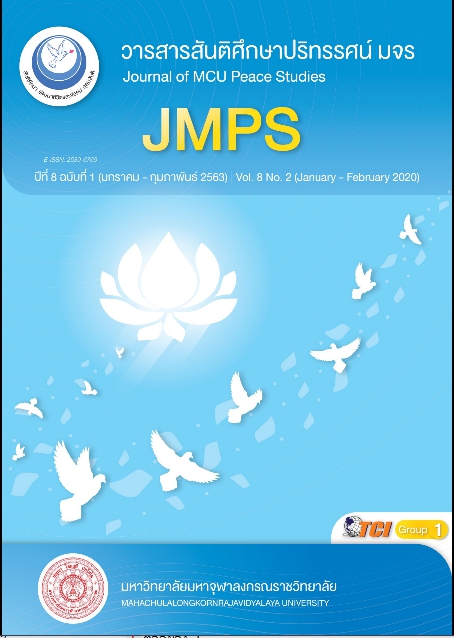ช้างในวรรณกรรมนิทานอีสาน:การสร้างอัตลักษณ์สัตว์และความหมายทางวัฒนธรรม
Main Article Content
บทคัดย่อ
บทความนี้มีวัตถุประสงค์เพื่อศึกษาช้างในเชิงการสร้างอัตลักษณ์สัตว์และความหมายทางวัฒนธรรมผ่านวรรณกรรมนิทานอีสาน 3 เรื่อง คือ ท้าวคัทธนาม นางผมหอมและสังข์ศิลป์ชัย โดยใช้กรอบแนวคิดเรื่องสัตวศึกษามาประยุกต์ใช้ เพื่อตรวจสอบและหาคำตอบว่า วรรณกรรมนิทานอีสานได้นำเสนอการสร้างอัตลักษณ์สัตว์ให้กับช้างในลักษณะใดบ้าง และการสร้างอัตลักษณ์นั้นมีความสำคัญต่อความหมายทางวัฒนธรรมอย่างไร จากการศึกษาการสร้างอัตลักษณ์ให้กับช้าง พบว่า 1) การสร้างอัตลักษณ์ด้านร้ายให้กับช้าง สะท้อนให้เห็นการแบ่งแยก ตัดขาดและเบียดขับสัตว์ให้ไกลจากสังคมวัฒนธรรมมนุษย์ บนพื้นฐานของมโนทัศน์ที่มองว่า ช้างเป็นสัตว์ป่าที่มีความป่าเถื่อน โหดร้ายและสันดานดิบ 2) การสร้างอัตลักษณ์ด้านดีให้กับช้าง ด้วยการสวมใส่พฤติกรรมและคุณลักษณะทั้งอารมณ์ความรู้สึก สติปัญญา และความสามารถบางประการให้เหมือนมนุษย์ และยกระดับให้สามารถกระทำจริยธรรมอันดีงามได้ ส่วนประเด็นความหมายทางวัฒนธรรมพบว่า 1) ช้างในฐานะสัญลักษณ์ของพลังอำนาจเหนือธรรมชาติ มีความลึกลับยากแก่การหยั่งรู้และอยู่เหนือ การควบคุมของมนุษย์ ทั้งยังเป็นตัวเชื่อมระหว่างโลกสามัญกับโลกศักดิ์สิทธิ์ 2) ช้างในฐานะสัญลักษณ์ของ การสืบเผ่าพันธุ์และเพศสภาวะ เป็นสัตว์ที่มีพลังอำนาจในการสร้างสภาวะการเจริญพันธุ์ ซึ่งเชื่อมโยงไปถึงการให้ความสำคัญทางเพศสภาวะระหว่างหญิงและชาย
Article Details
ทัศนะและความคิดเห็นที่ปรากฏในบทความในวารสาร ถือเป็นความรับผิดชอบของผู้เขียนบทความนั้น และไม่ถือเป็นทัศนะและความรับผิดชอบของกองบรรณาธิการ ยินยอมว่าบทความเป็นลิขสิทธิ์ของวารสาร
เอกสารอ้างอิง
Deesuankok, C. (2007). Regional Literature: Sin Chai. Khonkaen: Khonkaen Education.
Garrard, G. (2012). Ecocriticism. New York: Routledge.
Hongsuwan, P. (2001). The role of dogs in myths and rituals of various races in Southeast Asia. Once upon a time: About myth and culture. Bangkok: Chulalongkorn University.
Isan Literature Association. (1983). Nang Phom Hom. Bangkok: n.p.
Jaroenjitrakam, P. (1976). Northeastern literature: Sang Sin Chai. Thesis Master of Arts. Graduate School: Chulalongkorn University.
Johnson, J. (2009). The Philosophy of the Animal in 20th Century Literature. Faculty of the Dorothy F. Schmidt College of Arts & Letters in Partial of the Requirements: Florida Atlantic University.
Khongphianthum, C. (2016). Sacred animals in Khmer society. Journal of Language and Culture, 35(Special issue), 117-126.
Khotsongkhram, C. (2007). Esthetics in Two Lao Literary Work: Sang Sin Chai and maha wetsandon Chadok. Thesis Master of Education. Graduate School: Mahasarakham University.
Kinsley, D. (2009). Ecology and Religion (Supamantra, L Trans.) Bangkok: Plan Printing.
Namlao, A. (1986). Thao cut thanam. Nakhon Ratchasima: Cultural center of Nakhon Ratchasima.
Pinthong, P. (1981). Sang Sin Chai. Ubon Ratchathani: Siritama publishing.
Poonotake, T. (1981). Regional Literature. Bangkok: Odeon Store.
Poonotake, T. (2002). Regional Literature: Methodology and Question. Institute of Culture and Arts Journal, 4(1), 27-38.
Sangkhaphanthanont, T. (2017). Not just animal: Animal studies from the perspective of ecocriticism. Theories and Art Criticism Views of Thai Academics. Satchaphan, R. (Ed.). Pathum Thani: Nakhon.
Swangwong, K. (1988). A comparative study of a Lanna Thai, A Northeastern Thai and a Thai Lue versions of the Nang Phom Hom. Thesis Master of Arts. Graduate School: Silpakron University.
Thammawat, J. (1994). Regional Literature: Isan-Lanxang. Mahasarakham: Mahasarakham University.
Visuddhibedya, L. (1979). Elephants in Sanskrit and literatures. Thesis Master of Arts. Graduate School: Chulalongkorn University.
Wattanarat, S. (1989). A comparative study of “Nang Phom Hom” in the Lanna Thai and the Esarn Versions. Thesis Master of Arts. Graduate School: Chiang Mai University.
Wijit, C. (2015). Animal on Moral Actions in Theravada Buddhism. Earth, Water, Wind, Fire, Universe and Toxic: Hazard from the humanities perspective. Bangkok: Siam review.
Woradejnaiyana, K. & Hongsuwan, P. (2109). Snake in Isan Literature: Metaphors and Cultural Interpretation. Journal of Humanities and Social Sciences, 36(3), 278-303.


